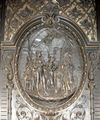Stock-im-Eisen (Vienna)
The Stock-in-iron is the middle part of a zweiwipfeligen Zwiesel spruce from the Middle Ages , which was misted over with nails. Such trunks are also called nail trees . The Viennese Stock-im-Eisen is the oldest surviving nail tree, the first written mention of it comes from the year 1533. The original is still in Vienna today , at Stock-im-Eisen-Platz 3, on the corner between Graben and Kärntner Straße , the so-called Palais Equitable .
The trunk is 2.19 m high and stands on a base made of Bohemian hornblende granite. The documented mention of 1533 describes it as a "stick that lies in the iron". This refers to a wide iron band of medium height with a dummy padlock. The engraved "HB" probably comes from the house owner Hans Buettinger, who had the ribbon renewed in 1575.
history
The spruce of the later Stock-im-Eisen began to grow around 1400 and, as studies in 1975 have shown, was felled around 1440. The taper in the middle of the trunk (it is supported by five metal bands) is due to blows from the ax. The nailing started when the tree was still alive (i.e. before 1440). In 1548 he was already at one of the houses on today's Stock-im-Eisen-Platz.
From 1715 onwards, journeymen were nailed to the Walz . However, this differs significantly from the medieval nailing. This custom is also known in other countries of the former Danube Monarchy and in Southeastern Europe, such nail trees can be found in many cities in Hungary and Romania ( Transylvania ).
Importance of nailing
The reason for the nailing before the 18th century is not known. The most likely theory for medieval nailing is the old custom of hammering nails into crosses, trees and even rocks for protection or to cure illnesses - as a votive offering , similar to the custom of the coin well or wishing well into which small coins are thrown . After all, in the Middle Ages nails were an expensive commodity that was not carelessly wasted.
The custom of blacksmiths and blacksmiths traveling through to perpetuate themselves with a nail did not arise until the 18th century. It is therefore unlikely that the stick-in-iron was originally a guild custom.
The second part of the relief at the Palais Equitable
Say
There are some legends about the stick in the iron that mainly date from the 17th and 18th centuries. They tell that the devil himself put the trunk in iron or that it was at least a "lock that cannot be unlocked". That's right, insofar as the lock is only a dummy and therefore actually no key is accessible. According to another legend, a thief drove a stolen nail into the tree when it got lost in the woods. Although the tree was outside the city walls until around 1440, this legend did not appear until the 17th century and is therefore probably a pure invention.
A modern legend claims that the stick-in-the-iron is a replica and that the original - at least parts of it - can be seen in the Wien Museum . This is not correct, the trunk has not been split or replicated in recent times.
See also
Web links
- Franz von Dingelstedt : Songs of a cosmopolitan night watchman in the Gutenberg-DE project
- Say about the stick in the iron on tell.at
- The stick-in-iron of the city of Vienna and its importance. In: Wiener Zeitung , July 14, 1859, p. 13 (online at ANNO ).
Coordinates: 48 ° 12 ′ 29 ″ N , 16 ° 22 ′ 18 ″ E





